Interview: RSC Director of Design Stephen Brimson-Lewis Talks MEASURE FOR MEASURE
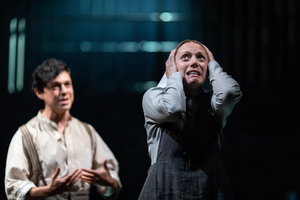
in Measure for Measure
This summer, As You Like It, The Taming of the Shrew, and Measure for Measure play in rep at the Royal Shakespeare Company. All three will tour the country, following their run at the Royal Shakespeare Theatre in Stratford.
Designing three very different shows for a number of very different spaces is no easy task. Fortunately for Director of Design Stephen Brimson-Lewis, he has over 20 years of experience designing for the RSC.
Reflecting on his time there and learnings so far, Stephen takes us through the collaborative process of designing one of the productions this summer: Measure for Measure.
How did you get started in the industry?
I went through I suppose what's now become a tried and tested route, where I studied at Central Saint Martins along with lots of other designers whose names you might know.
That was in the early 80's, which was rather a golden and brilliant time for the industry, certainly in terms of the West End. Being in the middle of London, studying the beginning of the big, mega musicals and the real blossoming of the National Theatre and the Royal Shakespeare Company at the Aldwych and various other places.
So it was very easy to immerse yourself in the world of it very quickly, and with a few skills you could find yourself a job in those days, which I did.
What inspired you to pursue a career in that field?
I suppose the inspirations were (if I'm honest) was the original production of Jesus Christ Superstar, something like that where they were impressive from a design point of view (even though I didn't even know the name of the designer at the time!)
Then looking ahead as well and RSC productions and the National Theatre, and just being absorbed in that. And the operas, English National Opera at the time. Stefanos Lazaridis springs to mind, some extraordinary productions that were both visually and musically very powerful. The 80's was a good time to grow up as a designer.
You've had over 20 years designing for the RSC - looking back, are there any particular highlights?
I think I've now designed 25 productions for the RSC! And a lot of them with Greg Doran [Artistic Director], our first one being Timon of Athens, which is probably just over twenty years ago now in the old theatre.
And a few other highlights along the way, lots of them. Particularly Greg and mine's production of Macbeth in the Swan, and working with Antony Sher and Harriet Walter to create a genuinely scary and intense production in a small theatre, which was a wonderful opportunity (you know, without the burden of having to create enormous sets to place the play).
The audience were locked in this room and you literally (as we did) turned out all the lights and scare everyone witless, which was a pretty good way to start the play.
I've also loved the kind of variety of plays we do. Lots of Shakespeare, but other plays as well like Death of a Salesman and The Merry Wives of Windsor musical with Judi Dench in the old RST [Royal Shakespeare Theatre] before it closed down. So there's quite a legacy now.
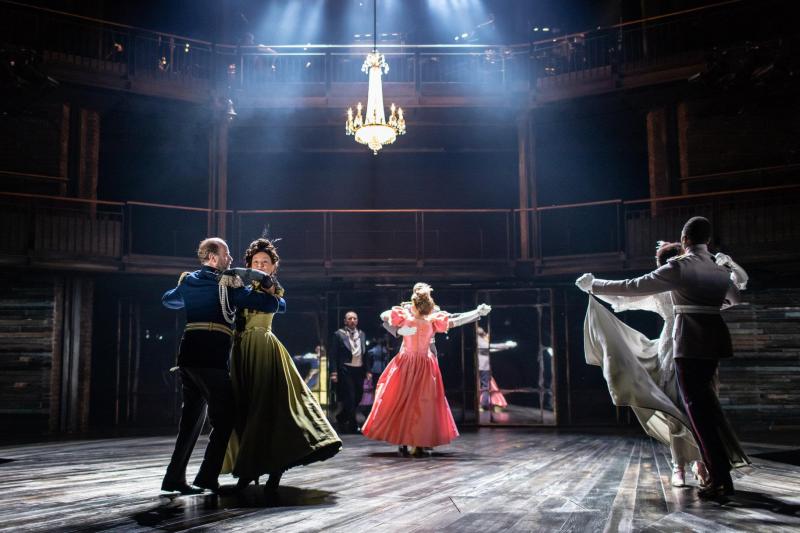
What are the changes you've seen during that time?
I suppose the spaces themselves, particularly the RST. That went from being a proscenium theatre to a thrust stage, and that has a particular kind of challenge to a designer.
To try and wrap the actors into the design in some form where you can't necessarily have great lumps of scenery because of sight-lines and getting in the way. So you have to to find another solution to designing a play.
So it makes you think in a different way, and it isn't like the Swan. The RST is a very particular space: it can be very epic when you want it to be and can be very intimate as well. You have to play both those cards in Shakespeare; you have to be very clever how you make that so.
From its epic point of view, the digital production I did of The Tempest with Greg, we could really exploit the scale of the building. And now recently in these past three plays (ending in Measure for Measure), we've tried to really make it intimate. Even though we've added 80 extra seats, we've made a real crucible, a sort of cockpit of a theatre that the audience look down into and makes it feel like a much more charged, intimate space.
What advice would you give to someone hoping to pursue a career in design?
I'd say don't underestimate your skills, what you have to offer in terms of either a model maker or a costume maker or a jewellery maker or a hat maker. I did a bit of that in my time in order to earn some money in between the design jobs.
And actually from those, you're learning the craft of being a designer, which is basically to balance between the technical aspects of the job and the artistic aspects of the job. And it's walking a path between the two.
So as much experience you can get on the technical side and as much as possible you can challenge yourself on the artistic side, then hopefully you'll start to offer something unique and you might find your way in the industry.
But it's true to say for every play that's put on, like for example at the minute there are 27 actors employed, there are two designers...if that. A costume designer and set designer, and sometimes its just the set and costume designer as one person. So that's the sort of statistics for how tricky it is to get work.
So using Measure for Measure as an example, how far in advance do you start planning your vision?
It's different from my point of view as Director of Design, which means I'm very embedded in the company and work very closely with Greg as Artistic Director, to know well in advance when the plays are planned. Well enough in advance to know that they might eventually have to work in rep with one another, so they'll have to change over between each other.
So it's a lot of planning. For this one, over a year in advance really. And at that point, I looked back on my iPad (which dates everything for me), and I see when I first started looking at Vienna, 1900, finding references and paintings. So well over a year ago, maybe even 18 months ago.
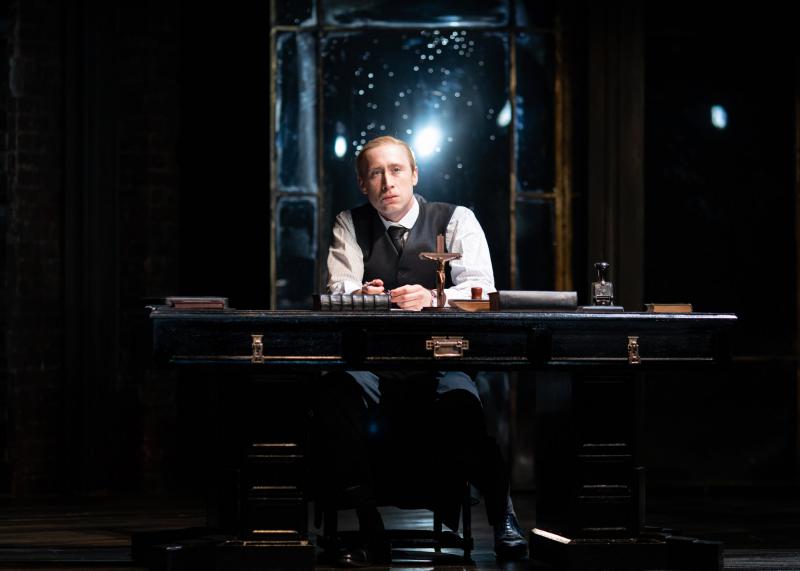
in Measure for Measure
Having worked together so much, you and Greg must have a good shorthand.
I think we do and I'm sure you hear that with lots of directors and designers who work together frequently. It's necessary as well as being a gift, in terms of the workload and the time scale for two people being very busy to try and find the moments to really work on the play in some detail.
I know now that from a very few clues from Greg, maybe an image of two that he might email me, I will instantly get a sense of the feel for the world. And he hopefully trusts me enough to then go off and flesh that out and make that happen.
So what were your key inspirations for Measure for Measure?
Greg's always very good about the historical context of a particular world, and we talked very loosely about what Vienna meant to Shakespeare and what Vienna means to us today. We would just sort of free associate and I would say, "Vienna would mean Gustav Mahler, Gustav Klimt, Orson Welles' The Third Man".
And he would say, "Yes! Me too, probably there somewhere." And we started honing it on on the build up to the First World War in particular, because the monarchy was going through crisis to a point where they then abolished the monarchy. The decline and collapse of the Habsburg empire meant that being a duke was a rather difficult time. So that was quite a good key.
But it was a cauldron of change in that part of the world, which we saw the consequences of all of that political upheaval through the first half of the 20th century. And Austria as we know, that's where the First World War really did begin with the shooting of the archduke.
But we didn't necessarily want to be so specifically historically based; we wanted to still be inspired by those alternative artists of the day. Those who were pushing the boundaries for what was accepted, what was tolerated in terms of art and self-expression and the introspection of Sigmund Freud.
It felt like such a fantastic place to put a play, any play, and it's a gift that Shakespeare said it was Vienna! So we were going to exploit it. And I think it has a resonance.
You could also say with this play that we could easily have done a very modern day production of it. And I think Greg and I both felt that somehow that would be reductive, that would be too on the nose if you like in terms of the #MeToo element in the play which we've kind of shied away from.
But there's clearly a moment where Isabella turns to the audience and says, "To whom should I complain?" In other words, "No-one will listen to me. Why would they listen to me, they're going to listen to him and his reputation will therefore support him and they will believe him not me". And you can't help but connect that to news stories of today.
But somehow to make it today seemed too reductive, as I say. By setting it almost exactly 100 years ago, I think the audience are allowed to make those connections for themselves without having it necessarily forced upon them.
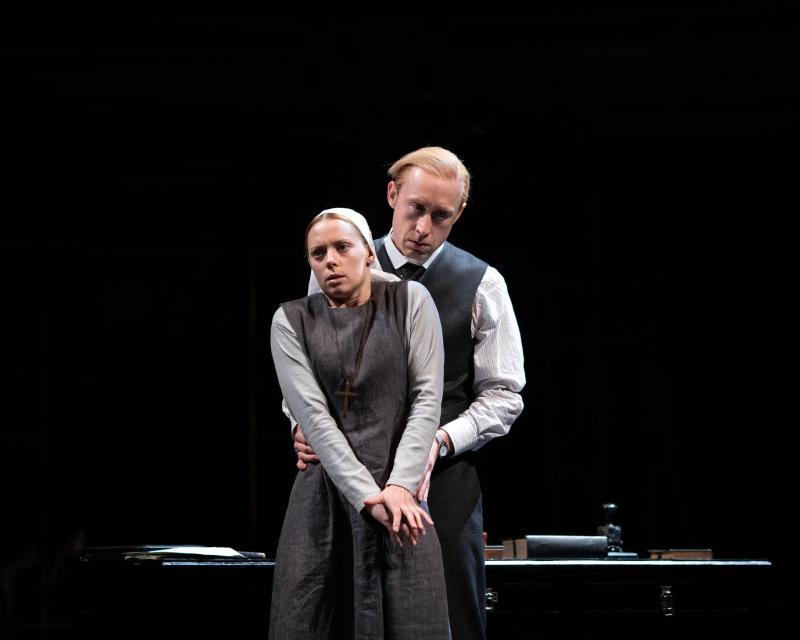
in Measure for Measure
One striking element in the design is the lighting, which has also been done in collaboration.
I love working with lighting designers generally. I'm very inspired by a fantastic designer called Josef Svoboda, who designed lighting and scenery himself. And looking back to the work of Edward Gordon Craig at the beginning of the century, where light was as much of a tool as anything else. It painted the scenery in a way.
Having now worked in this company as much as I have done and created working relationships with various people in the company, I was very keen to try and exploit the talent that was here in the building, certainly in the Sound Department and indeed in the lighting department.
To find those people who up to this point had been seen as technicians, so to speak. Absolutely at the top of their game who clearly had a great understanding of the building and the space, and Simon Spencer absolutely was that person.
We'd started work together on The Tempest, and I was so taken by his confidence in the building and the confidence in him of where to hang a lamp in that very particular space. So knowing I was going to be inspired by the film noir world of Orson Welles, lighting would be the major element of the design.
It was vital to find someone that I could work with over a long period of time, to develop the scenery and the various scenic elements to be light-friendly and light-sensitive. That's been a wonderful collaboration and together we've story-boarded the play almost in a filmic way.
With the RSC now transferring shows to London, do you have to take designing for different spaces into your initial consideration?
Well part of the brief was to try and re-purpose the RST, in order to make it a more intimate space. But in true fashion, they're not necessarily unambitious productions. They're big productions, there's still quite a large footprint that we have to negotiate transferring into other theatres.
We have the joy of taking it to the Lowry theatre in Salford and the Barbican first off, which are still big theatres and we expand in width and reduce the depth. Here, I suppose I see it as we're kind of portrait and at the Barbican we have to go landscape. And then we have to fit into much smaller houses around the country, so we take a slice out the middle of the design and make that work.
But that was in my head at the beginning. When I was designing the gallery structure for the RST, it was a response to the architecture of the RST but it was also thinking I needed a structure to fit the set for the other three plays into and on to and work with. So again, it's the balance of the technicalities with the artistic kind of flair.
I'm really pleased that at the end of it, the three productions in rep do look very different. I'd hope that people would be surprised to see that it was the same set designer on all three. Because I very passionately want the voice of the play to come through and not the voice and feel of the designer to override that.
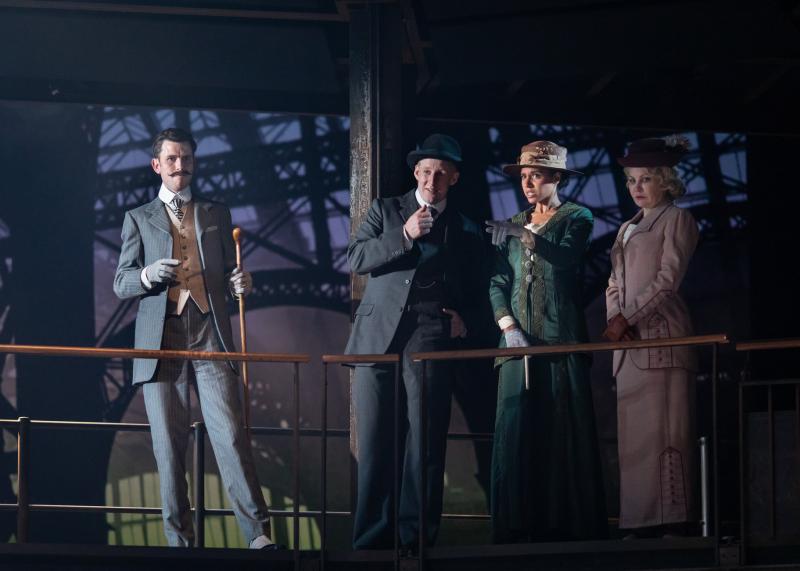
And all three do feel very different.
I always knew this kind of Orson Welles, filmic approach to Measure, the thriller aspect of the story and the duke of the dark shadows that it was going to have a certain sort of look and feel to it.
So some of the elements were already there in the other plays, we use some elements in a very different way in Shrew and in As You. They're just presented in a very different way and lit in a very different way.
And they were definitely three separate lighting designers and three separate directors and actually, I also collaborated with two other costume designers on the other two plays, both Hannah Clark and Bretta Gerecke. That was wonderful, to have another designer to collaborate and share the pressure with.
Measure for Measure at the Royal Shakespeare Theatre until 29 August.
Touring various venues in England 25 September 2019 - 4 April 2020 including the Barbican, 12 November 2019 - 16 January 2020
Photo credit: Helen Maybanks
Comments
Videos

